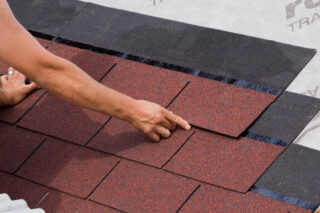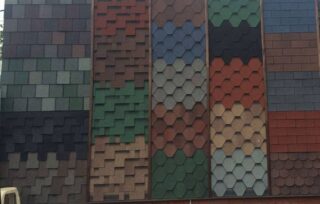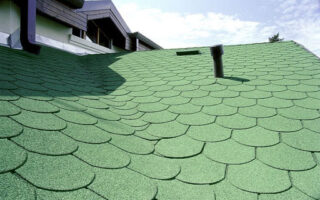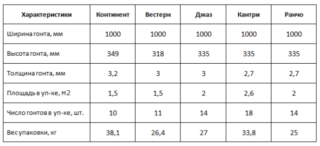Flexible roofing is very popular with both private and commercial developers. The reasons for the demand for the material lie in its high performance characteristics, presentability and the possibility of self-styling, without the involvement of specialists.
What is shingles

Flexible shingles are flat sheets-modules (shingles) of a certain shape with a figured cutout along the lower edge, which defines the pattern of the roof.
Products are overlapped on a solid base of flat and curved configuration. Fastening is carried out on glue with fixation with special nails.
The coating is used for the arrangement of private houses, engineering structures, objects of complex shapes.
The difference between shingles in the shape of the shingle cutting
Modern technologies combined with a design approach allow creating flexible cladding with the most sophisticated and attractive shapes.
There are such types of soft tiles:
- Hexagonal. Symmetry pleasing to the eye without sharp corners.
- Trapezoidal (Dragon tooth). An original composition that gives the building its own character.
- Rectangular. A classic where clean lines meet ergonomics.
- Asymmetric (Shingle). The lower parts of the plates imitate the edges of the boards. Perfect for houses made of timber and logs.
- Semicircular (Beaver tail). Curved edges will appeal to people who prefer a relaxed environment without corners.
- Diamond-shaped. An ergonomic solution that fits perfectly with all styles of buildings.
- Slate. The corrugated surface imitating a shiny stone looks expensive and original.
When decorating a house, you can combine different types of cladding. From the side of the facade, expensive and presentable models are stacked, and simpler products are used in the backyard.
Classification according to the number of layers

The performance of a coating is largely determined by its composition and thickness.
The following types of tiles are on sale:
- Single layer. Base impregnated with bitumen with adhesive backing and stone chips on the front side.
- Two-layer. Additionally, another layer of bitumen is applied, which makes the tiles more resistant to mechanical stress.
- Three-layer. It has two reinforcing layers, which provides additional strength and resistance to temperature changes. Some models have three levels, soldered together.
Single-layer products are lightweight, inexpensive, but their service life is no more than 10-15 years. More solid models are sturdy, look better, which affects their weight and cost. Nevertheless, expensive domestic tiles will easily lie on the roof for at least 50 years, even in the most unfavorable conditions.
Soft tiles, unlike metal tiles, are practically silent, look much better and more spectacular than even the most modern roll roofing material.
Assortment of soft tile colors
Modern technologies make it possible to create shingles with smooth and corrugated, matte and glossy surfaces. The color range is endless. The most popular are natural shades, familiar to everyone and consonant with the cladding of the surrounding buildings.These include red, brown, terracotta, green and gray.
In the catalogs you can find coatings for gold, silver and copper. Models with pronounced peach, light green, turquoise, beige and blue colors are available to consumers. Radically white and black finishes from established brands can be found if desired.
Material types depending on the substrate
For this, the following types of fabrics are used:
- Fiberglass. The canvas is obtained by heat treatment of refined quartz sand. The finest fibers of raw materials are intertwined with each other in a chaotic manner, forming many close ties. The fabric keeps its shape perfectly, bends easily, is soaked with fillers without any problems. It is prized for its environmental friendliness and resistance to decay. According to the established standard, the density must be at least 110 g / m².
- Fiberglass. Quartz is also a raw material, but the technology is radically different. First, the fibers are woven into threads, and only then into the canvas. With a lower strength, fiberglass is cheaper, but this is offset by an increase in the thickness of the fabric. Its density cannot be less than 130 g / m².
Both materials are equally practical, the difference determines the scope of their application. So the fiberglass is put on a single-layer coating, and thinner fiber webs on a multi-layer one.
Bitumen for the production of shingles

If the strength of the tiles is determined by the reinforcing base, then the flexibility, resilience and water resistance depend on its impregnation. For this, bitumen is used - one of the products of oil refining. Since in its raw state it melts easily in the heat, cracks in the cold and it is impossible to nail it, the raw material is subjected to additional processing.
There are such types of roofing bitumen:
- Oxidized. The manufacturing procedure consists in artificial aging by exposure to high temperature in combination with the addition of stabilizers. The material is inexpensive, but it hardens in the cold, which imposes a limitation on the seasonality of the installation of tiles.
- Modified. The product is obtained by mixing with chemical ingredients that eliminate the undesirable properties of the raw materials. Styrene rubber, atactic polypropylene and other substances used by manufacturers, but not disclosed in order to maintain trade secrets, are used as modifiers.
Reinforcing fabric is treated with a heated composition. Bitumen fills the pores, hardens, after which it becomes a single whole with it. Further, the following technological layers are applied to the filler.
Types of granules

All types of shingles are treated with hard powder on the front side. Its application is made by melting into the surface. The purpose of this procedure is to protect against ultraviolet radiation, mechanical damage and make the roof presentable.
The following types of granules are used in production:
- Basalt crumb. It is obtained by firing small fragments with the addition of polymers and pigments. The finished product is durable, shiny, and has the desired color.
- Shale chips. The crushed rock splits into flakes, which are fused into the bitumen in a continuous layer. A kind of armor with good protective properties is formed. The downside is that when the tiles are bent, the scales fall off.
- Anthracite. Natural carbon is tough, radical black and glossy. Such a coating is not very popular, as it looks gloomy and gets very hot in the sun. The solution is to add basalt granules and shale flakes to the coal, which ultimately gives a three-dimensional visual effect.
- Slag. The gray and black balls obtained from the melting of rocks do not shine, but are popular due to their discreet shade. They are widely used in combination with colored sequins. They are durable and UV resistant.
When choosing a material for roofing, you should dwell on options that do not fade in the sun and do not crumble from old age.
Sizes of shingles

The sizes of soft tiles are standardized:
- length - 1000 mm;
- width - 317-349 mm;
- thickness - 3.0-9.0 mm.
Shingles go on sale in packs of 22 pieces. This is calculated for the installation of three square meters of finished pavement. Its weight varies between 5-20 kg, depending on the number of layers and the technology used.









